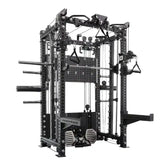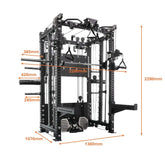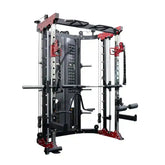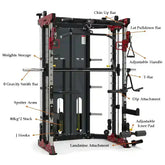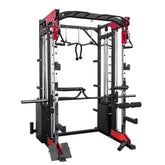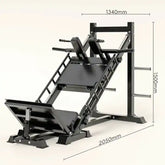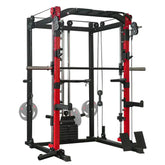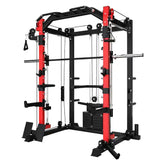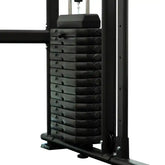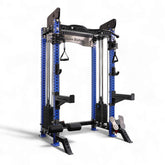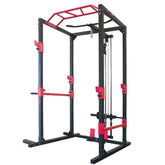Build a Powerful Back and Endurance Engine with a Rowing Machine
The rowing machine is one of the most effective tools for building a strong, wide back while improving cardiovascular endurance and total-body conditioning. Combine smart rowing technique with proper nutrition to maximise strength and recovery.
Build a stronger back and better endurance with a rowing machine — master form, increase resistance, and fuel every session with clean nutrition.
Why I Trust the Rowing Machine for Back Development

When I was training for bodybuilding competitions, my back was one of my proudest features — thick lats, strong traps, and that V-taper that made posing on stage a breeze. The secret? A mix of free weights and regular rowing work.
Most people underestimate how powerful a rowing machine can be. It’s not just cardio — it’s a full-body strength builder. After a decade of training athletes, I’ve seen firsthand how consistent rowing develops not only the back and posterior chain, but also conditioning, lung capacity, and endurance that other machines can’t touch.
Whether you’re a beginner or an experienced lifter, the rowing machine challenges every muscle in your back — from the lats to the erectors — while testing your stamina.
If you’re building your home gym, a quality rowing machine deserves a spot next to your dumbbells and squat rack. Explore the Rowing Machines at Alpha Go Fitness, designed for smooth motion, adjustable resistance, and lasting performance in both home and commercial gyms.
The Muscles You Build with a Rowing Machine
Every stroke on the rowing machine activates multiple muscle groups, giving you a total-body workout that builds both strength and endurance.
Lats (Latissimus Dorsi): The primary movers — essential for back width, pulling strength, and that signature V-taper.
Trapezius & Rhomboids: Strengthen the upper back and improve posture, especially for those who sit long hours.
Rear Delts: Help balance shoulder development and reduce injury risk during presses and pulls.
Core: Engaged in every pull to stabilise your torso and transfer power efficiently.
Glutes, Hamstrings, and Quads: The drive phase develops powerful legs that support every lift and sprint.
Think of rowing as a compound lift performed dynamically — like combining a deadlift, pull, and crunch in one smooth, rhythmic motion. It’s one of the most efficient ways to build muscle and endurance simultaneously.
How to Row for Maximum Back Development
I coach my clients to treat the rowing machine like any other strength movement — precise, controlled, and progressive. The right form builds strength faster, keeps your back safe, and maximises every session.
Step 1: Master the Four Phases of the Row
Each stroke has four key phases:
Catch:
Start with knees bent, arms extended, and your back flat. Brace your core and keep your shoulders relaxed — this sets your foundation.
Drive:
Push through your heels and engage your glutes and hamstrings. Keep the handle moving smoothly as your legs generate most of the power.
Finish:
Pull the handle toward your sternum while squeezing your shoulder blades together. Your torso should be slightly leaned back, chest proud.
Recovery:
Extend your arms first, then hinge forward at the hips before bending your knees to return to the catch position.
Step 2: Focus on the Mind–Muscle Connection
When I was competing, I didn’t just lift heavy — I focused on feeling every fibre contract. That same principle applies to the rowing machine. On each pull, consciously squeeze your lats and traps. Visualise your back doing the work instead of your arms
Over time, this focus deepens muscle activation, improves symmetry, and drives more growth from every session.
Step 3: Train in Both Strength and Endurance Zones
To maximise results, rotate between power-based intervals and steady-state endurance. Each style builds a different layer of back development.
For Building Muscle:
-
Row in short, explosive bursts of 30–45 seconds at high resistance.
-
Perform 4–6 rounds, resting 90 seconds between each.
-
Maintain strong posture and tension through your lats and core.
For Endurance and Fat Loss:
-
Use moderate resistance for 10–20 minutes of steady rowing.
-
Focus on smooth rhythm and controlled breathing.
-
Keep your pace sustainable — you should feel challenged, not gassed.
Both methods develop your back strength and cardiovascular engine, giving you the stamina to power through heavy leg days or long hypertrophy blocks.
Complementary Dumbbell Work for a Stronger Back
While the rowing machine builds overall back density and endurance, dumbbell training helps carve out shape, symmetry, and definition.

I often pair rowing sessions with dumbbell rows, lateral raises, and deadlifts for a complete posterior-chain workout that hits every angle.
Try this simple but effective superset:
-
8–10 Dumbbell Rows
-
12–15 Seated Rows on the Machine
-
Rest 60 seconds
-
Repeat for 3–4 sets
This combination gives you the best of both worlds — muscular tension and strength from dumbbells, plus continuous endurance work from the rowing machine.
If you’re setting up your own home gym, explore the Dumbbell Collection at Alpha Go Fitness for premium fixed and adjustable dumbbell sets built for both home and commercial use.
Nutrition for Back Growth and Recovery
A strong back isn’t built in the gym alone — it’s built in the kitchen, too. A rowing session can burn anywhere from 400–700 calories per hour, depending on your intensity and body weight. If your goal is muscle gain or endurance improvement, fuel becomes critical.
Here’s what I tell my athletes:
1. Eat to Perform
After your rowing session, your muscles are primed to absorb nutrients. Combine lean protein (like chicken, eggs, or a protein shake) with complex carbs (such as rice or oats) to replenish glycogen and kick-start recovery.
Aim to refuel within 45 minutes after training to maximise muscle repair and growth.
2. Stay Consistent with Hydration
Rowing is a sweat-intensive workout — especially at high resistance. Dehydration or electrolyte loss can limit performance and increase fatigue.
Add sea salt or an electrolyte powder to your water during longer sessions to maintain balance and endurance.
3. Support Recovery with Healthy Fats
Healthy fats aren’t just fuel — they help your joints and muscles recover.
Include omega-3 sources like salmon, walnuts, or flaxseed to reduce inflammation and keep your rowing performance strong and pain-free.
Coach’s Tip: Nutrition isn’t punishment — it’s a performance tool. Eating clean, balanced meals will help you recover faster, train harder, and stay injury-free, whether you’re rowing for strength, size, or conditioning.
How to Integrate Rowing into a Weekly Training Plan
You don’t need to row every day — balance is key. The rowing machine works your entire body, so recovery and variety are just as important as intensity. Here’s how I typically program rowing for my clients based on their goals:
|
Goal |
Frequency |
Duration |
Focus |
|
Muscle Growth |
2× per week |
15–20 min |
Short, high-resistance intervals |
|
Endurance & Conditioning |
3–4× per week |
20–30 min |
Moderate pace, steady breathing |
|
Fat Loss |
3× per week |
30 + min |
Consistent pace, low resistance |
For optimal results, pair your rowing workouts with squat rack and cable machine sessions to build strength from every angle. This combination develops powerful legs, a thicker back, and better overall conditioning.
Explore the Home Gym Collection at Alpha Go Fitness for equipment setups that complement your rowing program and help you train like a pro at home.
Common Rowing Mistakes to Avoid
Even experienced lifters can misuse the rowing machine — and small form errors can cost you big gains. Watch out for these common mistakes during your sessions:
1. Pulling with Your Arms Only
Rowing is a full-body movement. Power starts from your legs and hips, not just your arms. Drive with your lower body first, then finish the pull with your back and shoulders.
2. Slouching Your Back
Keep your spine neutral and your core braced throughout each stroke. Rounding your back limits power output and increases the risk of lower back strain.
3. Rushing the Recovery
The recovery phase should take about twice as long as the drive. Slowing down the return helps you maintain rhythm and tension — two keys for effective muscle building.
Good form equals more muscle engagement and less joint stress — essential for long-term progress, especially when you’re combining rowing with other compound lifts like squats and deadlifts.
Dumbbell and Rowing Synergy: The Hybrid Approach
The best physiques I’ve seen — from pro bodybuilders to CrossFit athletes — blend rowing machine endurance with dumbbell strength training. Each method develops a different dimension of power and physical quality:
Dumbbells: Build thickness, target isolation, and strengthen stabilising muscles for balanced development.
Rowing Machines: Build density, enhance endurance, and improve posture by training the entire posterior chain.
When combined, these two tools create a physique that’s balanced, athletic, and functional — not just aesthetic. You’ll develop strength that performs, not just looks good.
Final Thoughts from the Coach
When I coach athletes today, I always bring them back to the basics: move well, eat well, recover well. The rowing machine captures all three.
It’s not just another cardio tool; it’s a full-body weapon that sculpts your back, builds lung power, and tests your mental toughness.
When you combine consistent rowing with clean nutrition, proper recovery, and smart dumbbell work, the transformation speaks for itself. I’ve used rowing for years — not just to stay lean, but to build the kind of strength and endurance that lasts.
Train smart. Eat clean. Recover well. And let your back do the talking. Start checking your equipment here.
Frequently Asked Questions
Can I build muscle with a rowing machine?
Absolutely. When used with proper form and adequate resistance, the rowing machine helps build strength and muscle across your back, core, and posterior chain. It’s a powerful complement to traditional strength training.
How long should I row for muscle gain?
For muscle growth, aim for 15–20 minutes, 2–3 times per week, using high-resistance intervals. Focus on slow, controlled strokes that challenge your back and legs while maintaining good form.
Is rowing better than weightlifting?
They work best together. Rowing develops endurance, posture, and functional back strength, while weightlifting builds muscle mass and raw power. Combining both creates balanced, athletic strength.
What should I eat before a rowing session?
Eat a light meal 60–90 minutes before training that includes complex carbs (like oats or a banana) and lean protein (such as whey or eggs). This combination fuels endurance and supports muscle recovery.

